

| Home | For sale | Site map | Contact information | Guest book | The Panzerschreck Lounge |
 Training
with the
Panzerschreck Training
with the
Panzerschreck  |
|---|
The Panzerschreck training deviceThe
Wehrmacht always
tried to give their personnel the best possible training before
soldiers (and especially specialists) were sent to the front. Very
often shooting practice was done with sub-caliber weapons to keep the
cost of ammunition as low as possible. In the case of the Panzerfaust,
at least 3 different models of training devices were envisaged and
drawings distributed through the "Von der Front für die Front". They
were fabricated by the units themselves. These training aids would even
simulate the firing of a live rocket, just with the help of a
7.92x57 Platzpatrone 33. These training aids were manufactured using a
spent Faust tube. In the case of the Panzerschreck such a device was
not
possible, as the weapon was reusable. But the Heereswaffenamt was
clearly aware of the need for training aids.
On 26 November 1944 the "Progress report" from the Wa.Prüf des Heereswaffenamt stated:
With this in mind, the following picture is very exciting to study! 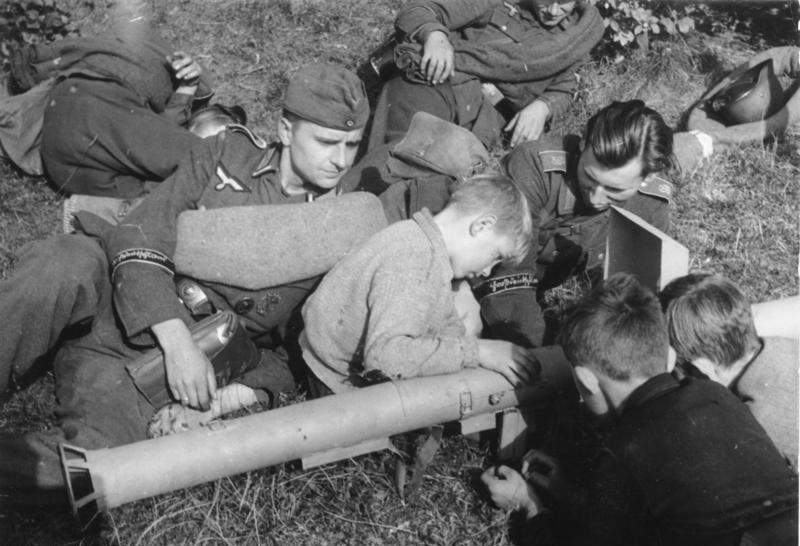 This picture is dated 10 October 1944, and was taken by Kriegsberichter Schwahn. The text on the rear (as written by the Propaganda-Kompanie) states: "Während einer kurzen Ruhepause, die die Grenadiere der Ersatzbrigade "Grossdeutschland" im Verlaufe einer Felddienstübung einlegten, benutzte die wissbegierige Dorfjugend die Gelegenheit, sich einmal alles "ganz genau" anzusehen.- Hier betrachten die Jungen interessiert den "Panzerschreck", die gefürchtete deutsche Panzernahbekämpfungs-Waffe [Raketen-Panzer-Büchse]." Scherl-Bilderdienst (Schwahn) 10.10.44 (During a field exercise, the grenadiers of the replacement brigade "Grossdeutschland" take a short rest. The inquisitive village children take the opportunity to study everything very carefully. Here the boys look interested at the "Panzerschreck", the dreaded German close range anti-tank weapon (Raketen-Panzer-Büchse). Scherl-Photoservice (Schwahn) 10.10.44) At first glance, the "weapon" pictured above appears to be a Panzerschreck, but a closer look will reveal that it is just a training aid! It's not the Übungsschiessgerät discussed above, as the drawings for that one weren't finished until 2 1/2 months after this photo was taken. Unfortunately, this is the only picture that is known that shows this training aid, and it is partly covered by the kids. The below picture is cleaned up to allow to focus on the details. 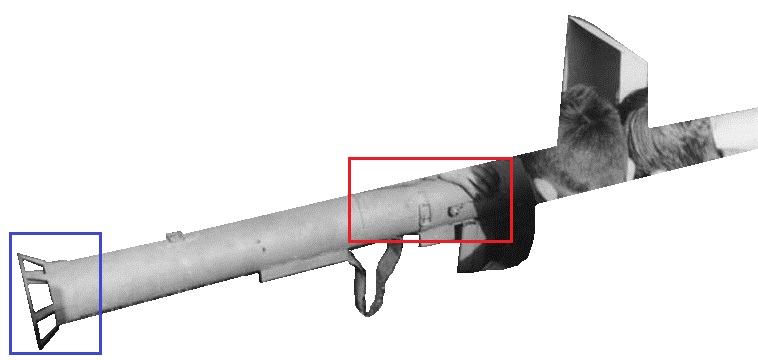 Blue square; the contact box and the grenade catch are missing entirely. This suggests that this device was not used for loading practice at all. A rear sling swivel has been added, but there is no sling. The device has some kind of shield, but it doesn't resemble the original shield. This one looks more like a open box. Red square; it has a lid, closed with a square clasp of some sort. A bolt handle appears to be positioned in front of the closing clasp. This training device must have been locally made by the unit's Waffenmeister. Probably based on the same thoughts that were behind the Panzerfaust training aids. Maybe a device for shooting Platzpatronen 33 was concealed under the cover. The original photo-text was clearly incorrect. Update! A good friend recently bought these pictures on Ebay. They show a mock-up Panzerschreck with a K98-type bolt action inside. The contraption seems to be missing the bolt. The measuring tape in inches and the fact that they are stamped "Confidential" on the back leads me to believe that they are results from studies of captured enemy equipment. This device is not identical to the one pictured above, but so similar that I tend to believe that there must have been a "Von der Front für die Front" issue that described how to make them, much like the instructions for the Panzerfaust trainer. 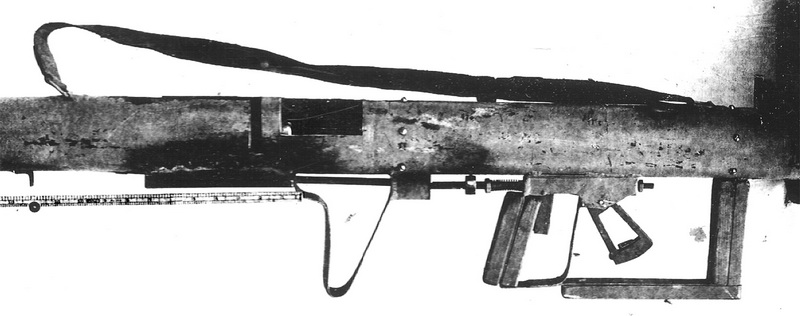 Picture reprinted here by courtesy of William Bogdan The resemblance to a real Panzerschreck is very good. There are two "rings" of screws holding the centering pieces that hold the rifle barrel. An opening has been cut in the tubing to allow the operation of the bolt handle. Although the Stoßgenerator appears to be present it is just a mock-up. The firing rod will in fact engage the trigger and sear of the rifle mechanism directly.  Picture reprinted here by courtesy of William Bogdan This model appears to have been made without a covering lid, in contrast to the one pictured with the Grossdeutschland Grenadiers. Update II! My friend Bogdan has once again found some interesting information in his archives. The following pictures appeared on Ebay some years ago and show some pages from a H.Dv (Heeres Dienst Vorschrift). Unfortunately, it is impossible to get a clear enough view of the number to positively identify it. But from what I can see combined with a list of published manuals I am pretty sure that the pages comes from H.Dv 298/20c Ausbildung und Einsatz der Panzergrenadiere The pages are marked "Anlage 2" (appendix 2 to main body). 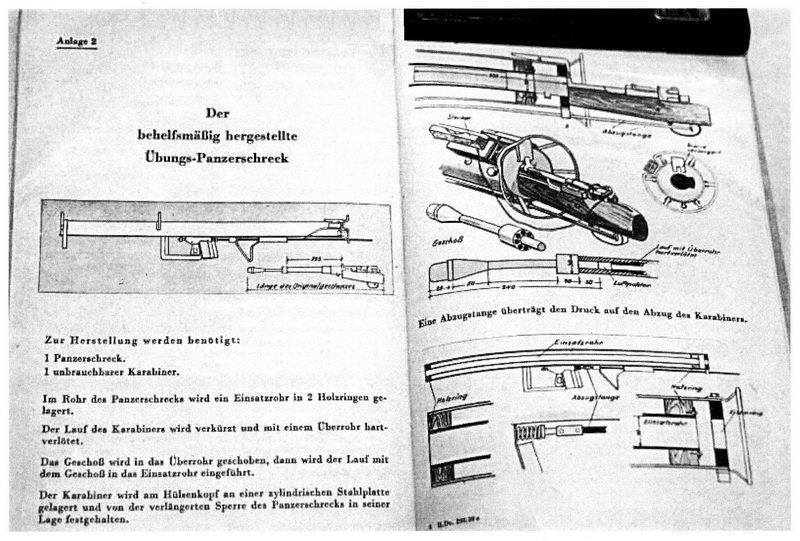 They show building plans for a field-conversion that turns a Panzerschreck into a Panzerschreck training device. The actual Panzerschreck is severely modified in the process and cannot be used as a weapon when the contraption is removed again without serious repairs. A inner tube was mounted inside two wooden disks in the actual Panzerschreck. The Stoßgenerator was removed and the firing rod was made longer. A (damaged) K98k type bolt action rifle is soldered to a larger tube that would fit perfectly inside the reduced bore of the Panzerschreck. A wooden dummy projectile is inserted into the tube of the K98k, and the whole projectile/K98k mechanism is then acting as a "live round". It is loaded into the Panzerschreck like a normal round, and is arrested in position by a modified catch. It even has a dummy wire and wooden handle to attach to the contact box. Pulling the trigger will release the firing rod that will in turn strike the trigger of the K98k mechanism. The K98k mechanism is loaded with a blank (Platzpatrone 33) that will produce a "bang" and gases, that will in turn propel the wooden round that will leave the Panzerschreck. A certain amount of recoil will also appear, not matching the real McCoy, which would be recoilless. These plans made it possible for a skilled Waffenmeister to turn a damaged/unserviceable Panzerschreck into a training device. Not to be confused with the earlier mentioned plans to manufacture a practice shooting device. Loading practice with the Panzerschreck Apart from hitting the target the first time, ability to hit it again as fast as possible was judged as critical. The loading sequence had to be drilled over and over again to perfection to achieve this. The training tool for this purpose was the 8,8cm R. Pz B. Gr 4329 Ex. It was a standard grenade filled with tare to simulate the weight, and it had no rocket motor installed.  Elderly men of the Volksturm during loading practice with a 8,8cm R. Pz B. Gr 4329 Ex grenade. The picture is clearly staged. No instructor would line up his pupils like this during class. Shooting practice with the Panzerschreck A "cold" grenade was also developed. It had a "live" rocket, but a dummy warhead. It was the 8,8cm R. Pz B. Gr 4320 Bl. (Blind). It was marked with "4320 Bl" in black on two opposing sides of the warhead according to the instructions. But the only example I have found had only "Bl" painted in white on one side. Weight was the same as the 4322, so it must have had some kind of filling to compensate for the missing explosives. It was used for target practice only, and would of course be cheaper to manufacture than the 4322. 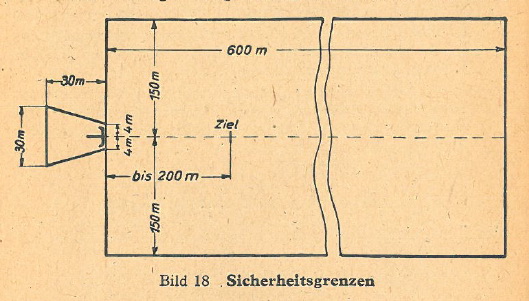 This picture shows the safety perimeter/set up for target practice, shooting the Panzerschreck. The target was placed within 200 meters, but the safety zone was 600 meters. The accompanying text states that the allowed elevation had to be "within the norm of shooting at a target at 200 meters". At an elevation of 45 degrees the rocket could go out to a distance of 1000 meters.  A fine day at the range! Instructional demonstration with a very large crowd of spectators. Early issue weapon being demonstrated in France, spring 1944. Note the lack of finger protection. Instruction with the Panzerschreck The following document was found in a file for a NCO course conducted in 1944. The candidates were briefly trained in all kinds of infantry weapons, so it was not a complete "designated" course for the Panzerschreck, it was only a orientation, meant to give them insight. The lesson below is a combined one for two weapon systems. I have translated the schedule part that is about the Panzerschreck. Note that the time available was divided on the two different systems.  Instruction at Panzerschreck and Pak:
Instructional materials for the Panzerschreck All the printed matter, especially the manuals, for the Panzerschreck were part of the educational "package". In addition a series of 54 Dias frames was manufactured. It was called "Panzernahkampfwaffen" Teil 1: Panzerschreck. Reihe 149a. (Part 2 was for the Panzerfaust and part 3 was for the Gewehrgranatgerät). Accompanying the Dias pictures was a text booklet used by the instructor. 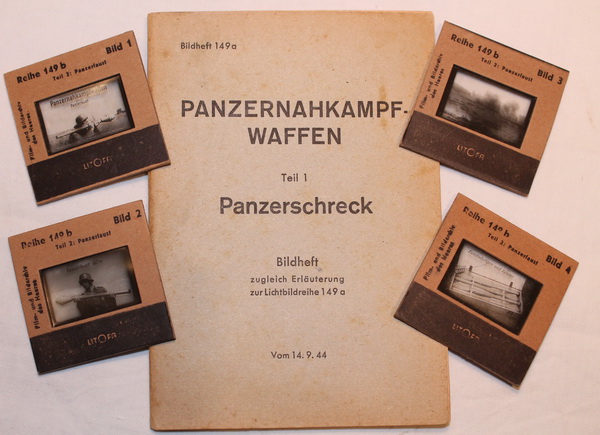 The keen observer will notice that I have the correct booklet, but the wrong Dias series. This is the 149b Panzerfaust series, and not the 149a. But hey! Beggers can't be choosers... Assorted pictures from the Dias series "Panzernahkampfwaffen" Teil 1: Panzerschreck. Reihe 149a. If a light projector was unsuitable, like close to the front, a box of 20 booklets could be used instead. Every third soldier held a booklet so that the men on his left and right could watch the booklet simultaneously. The "Merkblatt 77/2 8,8 cm R-Panzerbüchse 54 (Ofenrohr) Richtlinien für Ausbildung und Einsatz from 04 November 1943 regulated the education of the troops in the tactical use of the Panzerschreck. 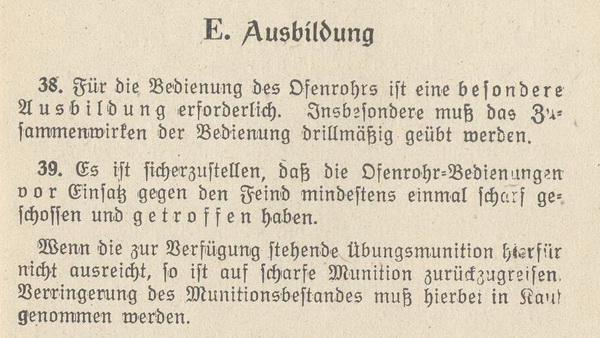 I have translated the section E. of the manual and retyped it below. E.
Training
38. For the operation of the Stovepipe special training is required. In particular, the interaction of the crew must be drilled. 39. Make sure that the Stovepipe crew have fired live ammunition and hit a target at least once before they are committed to action against the enemy. If the available training ammunition is not enough, live ammunition must be used. Reduction of ammunition inventory must then be taken into account. 40. Firing the Stovepipe requires practice in estimating the distance, speed and directions of armored vehicles and the resulting lead range. 41. Familiarization with the disability of the vision and the handling of the gun caused by the protective clothing on the battlefield is of particular importance. 42. The tank destroyer groups should be particularly trained for close combat with tanks. To overcome the "Tank-fear",* training should include being rolled over by a tank at least once when hiding in a foxhole. 43. The members of the tank destroyer units should be trained in armored recognition service according to the H.Dv.469/2 so they are able to recognize their own and the enemys tanks properly. 44. For training the following manuals must be used: a) D 1864/2: 8.8
cm R
Pz B 54 with 8,8 cm R Pz B Gr 4322 User instructions
b) H.Dv. 469/4:"Guidelines
for Close combat with tanks"
c) Leaflet
OKH/GenStdH/GendSchTr/No. 1578/42 "Close
combat with tanks"d) H.Dv. 469/2a: "Tank-recognition
service, Soviet Russia"
e) H.Dv. 469/2b:"Tank-recognition
service, England-America"
f) H.Dv. 469/3e:"Tank-target
boards (Defense against difficult to take out armored vehicles)
Infantry"
*This is
the first recorded use of the word "Panzerschreck". See
the section about history and
development.
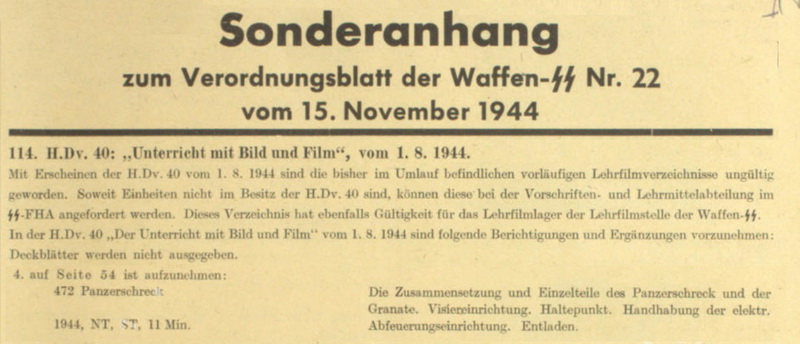 The publication above describes how to update the Heeres Dienstvorschrift 40, issued 1. August 1944; which is a picture & film catalogue for educational material. Entry number 472 on page 54 (very appropriate!) is about the Panzerschreck. A certified operator The personnel that had completed their basic training with the Panzerschreck got the weapon added to page 20 in their Wehrpass. 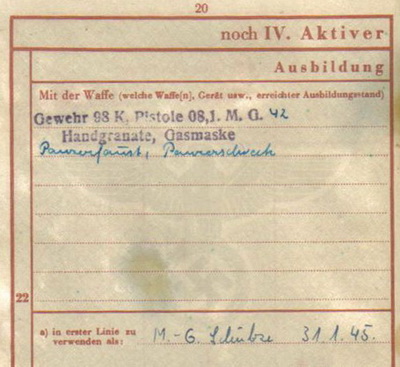 Page 20 listed the weapons and equipment that the individual soldier had been trained with. The Wehrpass was not carried by the individual soldier, but was kept as service records with the company clerk. 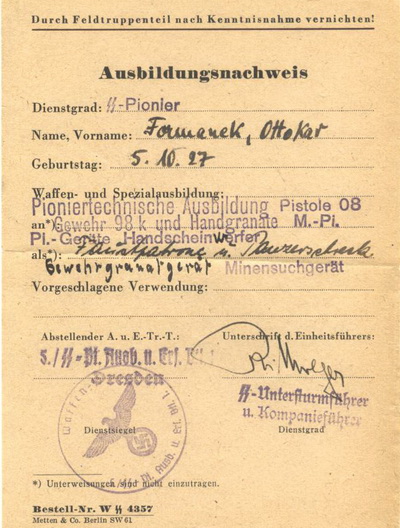 The picture above shows a separate sheet that contained much of the same information as the Wehrpass, but functioned as a certificate. Among other specialties, the soldier has been trained as an operator of a handheld searchlight and a mine-detecting device. Listed are also "Faustpatrone" (Panzerfaust), Panzerschreck and Gewehrgranatgerät. 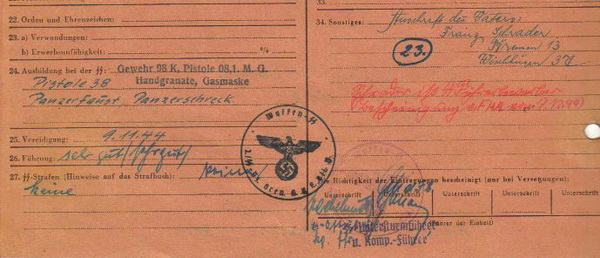 Another type of personal record. Listed here are the weapons that the individual has been trained with in the Waffen SS. Let us finish this chapter with a very "telling" picture that is just too good to not include. 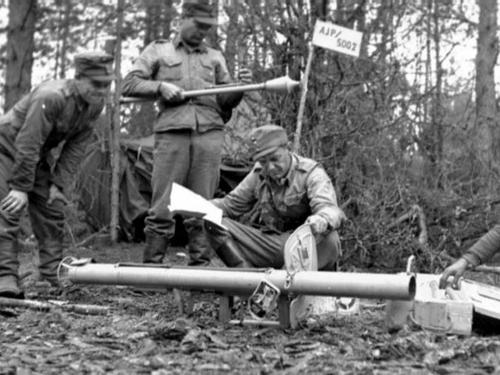 According to the pages about the Finnish army 1918 - 1945 the Finns received their anti-tank weapons bought from Germany in the summer of 1944. Due to the Russian offensive the weapons were shipped directly to the front and put to good use against the advancing Russian tanks. Unfortunately, there was no time for training or education. This picture appears to show Finnish soldiers inspecting their newly acquired AT weapons and figuring out what-is-what from a temporary "manual". Shit could happen to both friend and foe during such circumstances, and also did! NEW ADDITION  The above picture was part of an appendix (Sonderanhang) to the Verordnungsblatt (regulations) der Waffen-SS from 15. November 1944. The text body regulates corrections to the manual H.Dv.40 "Unterricht mit Bild und Film" (Teaching with picture and film). According to this a 11 min long instructional film has been created about the Panzerschreck. Unfortunately no copy of the film has been found to date. |
| Home | For sale | Site map | Contact information | Guest book | The Panzerschreck Lounge |